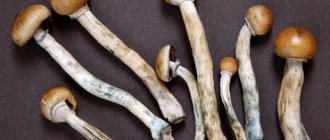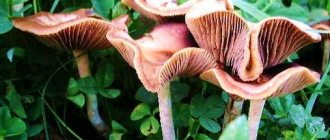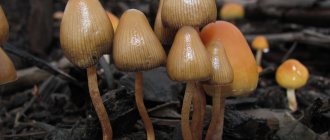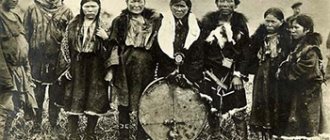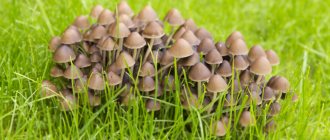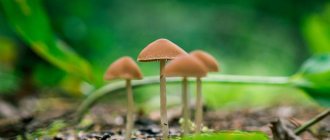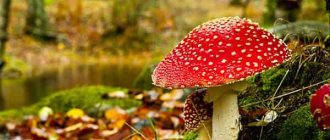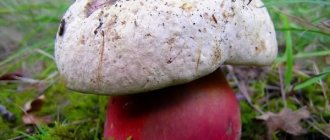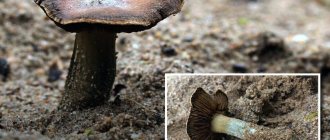Psilocybin belongs to a group of powerful psychedelic drugs. It is found in the stems of hallucinogenic mushrooms and is comparable in effect to LSD. In ancient times, this substance was used by shamans in Africa and India in various rituals. In the modern world, psilocybin is officially recognized as a drug , so storing, growing and selling such mushrooms is prohibited.
How do psilocybin mushrooms affect humans?
Once the drug enters the body, it stimulates the production of serotonin, the hormone of joy , so the person experiences lightness and euphoria. Reality in his perception is distorted. If the patient was depressed before taking the dose, then all unpleasant experiences may disappear (there are also cases of “bad trips” when a person is in a panic).
, psilocybin reaches the brain through the bloodstream , as a result of which all vital processes in the organ stop. It is at this moment that the drug addict is overtaken by visual and auditory hallucinations. The sensations when taking this drug are reminiscent of the effect of LSD, but the effect of the latter lasts longer and the psyche suffers more noticeably from it.
The first encounter with psilocybin is usually perceived as something fun and fantastic. People who use hallucinogenic mushrooms do not even think about treating drug addiction, much less about the reasons that led them to the desire to escape reality.
Types of mushrooms and methods of consumption
There are about 190 species of hallucinogenic mushrooms in nature, but the most common are species of the genus Psilocybe and Conocybe, growing in the climatic zones of Mexico and South America, Malaysia and Indonesia. They are available for collection at the end of summer, but they can be harvested (dried) for future use. Mushrooms containing psilocybin can also be grown at home, making the drug very accessible.
In order for the magic mushroom to work, it is eaten or brewed as tea. The powder itself has a bitter, unpleasant taste, so many people add it to other dishes, but the hallucinogenic substance does not lose its properties, even after heat treatment.
The effects of psilocybin begin 30-40 minutes after consumption.
How to recognize a drug addict using psilocybin mushrooms?
It is believed that hallucinogenic mushrooms do not cause physical dependence. Craving is explained solely by psychological discomfort that occurs in the absence of a dose . One unique thing about psilocybin is that it affects people differently. There are several phases of drug action:
- At the first stage of consuming psilicybin mushrooms, there is a slight deterioration in memory, and color and sound perception becomes more subtle.
- Subsequently, the person begins to notice that he is overly relaxed; all real events seem to him to be incredibly slow. Periodically, his consciousness spontaneously turns off.
- The first hallucinations finally take the addict away from reality. He does not react to anything, his body temperature drops, his pulse slows down.
- At the next stage, the patient loses self-identification. He ceases to understand where he is, what day of the week it is and what time of day it is.
- The addict is absolutely indifferent to what is happening around him. It seems to him that he lives outside his body.
Typically, the effect of mushrooms containing psilocybin lasts several hours , but “echoes” of the drug can be present throughout the day.
Addiction treatment
You can refuse hallucinogenic mushrooms on your own, but only if there has been only one use. If you do not stop taking it immediately, it will be much more difficult to do so and you will need urgent help from a narcologist.
If you have psilocybin addiction or your loved one suffers from it, the Healthy Sochi drug treatment clinic will come to your aid. The clinic will help you fight drug cravings and safely get you out of the drug trap.
Sign up for a free and anonymous appointment, and a center specialist will create an individual treatment program for you. Start taking care of your future by making a phone call.
What are the dangers of psilocybin addiction?
The main danger that faces a drug addict in the early stages of use is severe poisoning with psilocybin mushrooms and the resulting gastrointestinal disorder. There is no serious withdrawal syndrome after the psychoactive substance leaves the body.
However, for several more days residual manifestations of drug intoxication remain. If you take hallucinogenic mushrooms regularly and for a long period of time, your psyche begins to suffer : anxiety, panic attacks and other pathological manifestations occur. Over time, a person’s personality can completely collapse and irreversible degradation can occur.
In order to prevent such consequences, it is necessary to seek help from professionals in a timely manner. RC "Phoenix" provides treatment after spice, salts and other types of drugs according to modern standards. For any questions, call us at our contact number.
From “magic mushrooms” to evidence-based medicine
6 minutes
2485
Scientists at Johns Hopkins University in Baltimore, Maryland, have published the results of a study of the long-term effects of a single dose of the hallucinogen psilocybin found in “magic mushrooms” on healthy volunteers. They concluded that such a technique, carried out in the context of proper training and support from a specialist, increases the feeling of well-being and life satisfaction, and this effect persists over a long period of time.
36 people were selected on the basis of physical health, sufficient education (at least college) and the absence of a family history of psychosis and bipolar (manic-depressive) disorders. None of them had previously used psilocybin or other hallucinogens. The volunteers were psychologically prepared for the upcoming experiment; during the action of the substance (about eight hours) they were under the supervision of a specialist. Some of them reported episodes of fear or anxiety, but these unpleasant sensations were not long-lasting, and medical examination did not reveal clinically significant disorders. The comparison group received an active placebo in the form of the psychostimulant methylphenidate (Ritalin). After the experience, volunteers were asked to fill out a questionnaire.
The majority of subjects described the experience of taking psilocybin as “the most or one of the top five most significant personal and spiritual experiences in their lives,” with an apparent increased sense of well-being and life satisfaction after the experiment. After 14 months, all volunteers were asked to fill out the same questionnaires, with the addition of questions about the long-term effects of the experience. It turned out that positive changes in the perception of life and a high personal assessment of experiences persisted for the specified period in the absence of any side effects.
From time immemorial
The study by American scientists is not the first manifestation of interest in the properties of “magic mushrooms” and their active components.
The first known evidence of the use of hallucinogenic mushrooms in shamanic rituals was obtained during the study of Mesolithic cave paintings dating back to the Capsian culture of the 11th-7th millennia BC. in North Africa.
The most widely used “magic mushrooms” belong predominantly to the genus Psilocybe
, were used in Native American cultures. Indians of the Mayan, Aztec, Mazatec and some other tribes used them for ritual, “visionary” and medicinal purposes. With the arrival of Europeans on the American continent, many rituals, including those associated with mushrooms, were persecuted by the Catholic Church as idolatry. Because of this, they lost their popularity and survived only in remote, hard-to-reach areas.
Over time, the memories of Europeans about psilocybes were overgrown with so many fabrications and inaccuracies that by the beginning of the twentieth century, many scientists were inclined to believe that “magic mushrooms” were either a myth or were incorrectly described peyote cacti ( Lophophora
williamsii
), containing an amphetamine-like hallucinogen mescaline.
This view was refuted by the research of ethnobotanists Blas Pablo Reko, Richard Evans Schultes and Robert Gordon Wasson. In 1955, Wasson and his wife Valentina and mycologist Roger Heim, during an expedition to the Mexican province of Oaxaca - the habitat of the Mazatecs - became the first representatives of Western civilization to take part in the “mushroom ritual”. Wasson outlined his impressions in a publication in the large-circulation Life magazine. Heim identified hallucinogenic mushrooms as belonging to the genus Psilocybe
. Samples of mushrooms were delivered to Swiss pharmacologist Albert Hofmann, who was the first to synthesize and study the effects of LSD. Hoffman isolated, described and synthesized the artificially psychoactive components of mushrooms, called psilocin and psilocybin.
The notorious Harvard psychology professor Timothy Leary, inspired by Wasson's publications, repeated his Mexican experience. Returning to Harvard in 1960, together with colleague Richard Alpert, he opened the Harvard Psilocybin Project, designed to study the psychological and religious aspects of taking psilocybin and other hallucinogens, and in fact popularizing their use. In addition, the possibility of using the substance in the treatment of personality disorders and psychological counseling was studied. After being removed from their professorships in 1963, Leary and Alpert (who later took the spiritual name Baba Ram Dass) continued their activities outside Harvard, essentially becoming the “godfathers” of the nascent hippie movement.
Thanks to these events, the use of hallucinogens has become widespread throughout the world, with psilocybin becoming the most widespread, since psilocybes grow everywhere and are also relatively easy to cultivate. This has led to increased attention to "magic mushrooms" from both researchers and law enforcement. Throughout the 1960s, the pharmacology and toxicity of psilocin and psilocybin were studied and attempts were made to use them to treat psychiatric conditions such as obsessive-compulsive disorder. The reliability of works on this topic is questionable due to the subjectivity of researchers and violations of the rules for conducting scientific experiments.
Psilocybin, along with LSD and other indolic hallucinogens, was used by Czech-American psychologist Stanislav Grof in his research that led to the creation of transpersonal psychology.
The widespread and uncontrolled use of hallucinogens and the growing number of related incidents led to the ban on these substances in most countries by the UN Convention in 1971. This ban, on the one hand, somewhat reduced the consumption of hallucinogens and transferred their trafficking to an illegal basis, and on the other hand, it significantly hampered scientific research in this area. Despite this, some scientific institutions, in particular Johns Hopkins University, managed to obtain a license to work with these substances and study them, now according to all the rules of evidence-based medicine.
What's the point
The alkaloid psilocybin, found in magic mushrooms, is a proactive compound that is converted in the body to the psychoactive psilocin (found in smaller quantities in mushrooms) by splitting off a phosphoric acid residue. It acts as a stimulant of serotonin (5-HT) receptors, predominantly of the 5-HT1A, 5-HT2A and 5-HT2C subtypes. Low toxicity and does not cause drug dependence.
Physical effects
psilocybin/psilocin effects are dose-related and may include loss of appetite, nausea, chills, sensory disturbances, mild limb weakness, and dilated pupils.
Sensory effects
can affect almost all senses, primarily vision and hearing. Also characteristic is a disturbance in the perception of time, which can subjectively slow down or speed up.
Colors become brighter and more contrasting, halos around illuminated objects, distortion of perspective, a luminous “haze” in the air, surface mobility such as flow, ripples, pulsation or deformation, kaleidoscopic movement of textures, changes in the color of objects, luminous trails of moving objects are often observed. As the dosage increases, more complex and well-formed spatial hallucinations appear in the form of changing images and landscapes that occur both with open and closed eyes.
Sounds acquire unusual purity, the melody can slow down, speed up, or acquire effects similar to equalizer manipulations. Synesthesia is characteristic when sounds generate visual images and vice versa.
Emotional Effects
can range from delight to horror, from disorientation to crystal clear thinking, from bliss and euphoria to anxiety and fear. The nature of these effects strongly depends on a person’s informational preparation for the action of substances, his initial mood, the environment and people. That is why American researchers warn that uncontrolled use of psilocybin can harm both the person himself and others. At the same time, they came to the conclusion that the action of the substance in proper conditions and under the supervision of a specialist does not lead to long-term and severe unpleasant sensations.
Psychological effects
in general, include increased introspection, a change in the assessment of one’s own experiences (including traumatic ones), a new look at significant aspects of life (up to changes in the value system), concentration of thoughts and memories, in-depth thinking about life, as well as mystical experience in the form unity with nature, “higher powers”, “absolute”, etc.
It was the psychological effects of psilocybin, which determined the positive results of the experiment, that allowed scientists from Baltimore to conclude that the substance is promising for the psychological adaptation of cancer patients and people with drug addiction. Of course, subject to appropriate preparation and treatment in appropriate conditions in the presence of a specialist.
Theoretical contradictions to the potential effectiveness of psilocybin therapy have not yet been obtained, but a series of additional studies are needed to implement the technique. One of them is being prepared by the same group of researchers, it will include people with psychological distress due to existing or treated cancer. This study, in addition to examining the safety and effectiveness of the method, will serve as the basis for the development of specific recommendations for the use of psilocybin for medicinal purposes.
In addition, if the experiment is successful, the introduction of psilocybin into clinical practice will require the creation of a legal basis for its use, since this substance is currently prohibited for medical use. That this barrier can be overcome is evidenced by the fact that the medical arsenal includes many drugs classified as controlled substances, such as opiates, ketamine, some amphetamines and other substances.
Oleg Lishchuk
Useful facts
The group of psilocybin mushrooms, which includes sulfur head, have a number of characteristic features by which they can be easily recognized:
- miniature hat of yellow, olive or red color;
- the upper plate grows to the leg or descends along it;
- granular spores, usually brownish-purple in color;
- cartilaginous structure of the leg.
Having knowledge of what a potentially dangerous mushroom looks like, what the mechanisms of action of toxic substances are and what consequences threaten its use, you can prevent intoxication or promptly provide first aid to the victim.
What hallucinogenic mushrooms can you find?
Mushrooms contain psychoactive substances, including:
- The first category includes fly agarics - toadstool, royal or panther.
- The second category - psilocybes, contain the basic substance psilocin.
The effect after use is observed after about a quarter of an hour and lasts for 3-4 hours.
Under the influence of a narcotic substance, a person experiences a complete or partial loss of reason, consciousness changes completely. You can help a person only if you provide emergency drug treatment hospitalization. In the rehabilitation center there is a “call a narcologist to your home”. A team of specialists will provide competent assistance at any stage of intoxication.
Risk of overdose
Narcotic mushrooms cause dangerous mental disorders. After them, there are attacks of uncontrollable rage, attempts to commit violence against innocent people. While in a state of drug intoxication, the patient may try to kill anyone who comes into his field of vision.
If the dose taken was very large, the drug addict not only loses control over his behavior, but also loses the ability to control his own body. If he is not provided with emergency medical care, it is likely that death will not be avoided.
Effect of action (trip), symptoms of poisoning and first aid
Sulfur head is a mushroom with high hallucinogenic activity. Its use has a profound effect on human consciousness. The effects are similar to the consequences of using the drug LSD. This condition is called a trip.
In terms of external manifestations, the behavior of a person who consumes mushrooms is similar to that of a person suffering from schizophrenia.
The first signs of poisoning appear after 15–20 minutes, but taking it on a full stomach can delay the onset of the trip. At first the person gets lost in space, then delirium sets in and he feels dizzy.
One gets the feeling that time stops moving or, on the contrary, rushes forward at an unrealistic pace, and space contracts or expands.
Light and color stimuli are perceived in a modified form. The sensitivity of the organs of hearing and vision is greatly enhanced. The mind seems to be outside the body.
Experiences caused by damage to consciousness can be both positive and negative and affect a person’s mood and general condition.
First aid consists only of preventing a person under the influence of brimstone from committing dangerous actions. After some time, the effect will go away on its own.
Dangerous twins
| Psilocybe blue | While completely similar to the chamois head, it has a distinctive feature in the form of fused legs. The fungus can cause a powerful disruption in the functioning of the nervous system and affect vision and hearing. |
| Psilocybe Czech | Unlike the chamois head, it has a thin stalk. Causes powerful hallucinations. |
| Psilocybe mexicanis | Has a hallucinogenic effect and can cause severe vomiting. It differs from the chamois head in the blue color of the legs. |
What happens as a result of using narcotic mushrooms
Symptoms experienced after using herbal drugs vary. They depend on the type of plant, its dose, the individual characteristics of the human body, mental state and some other factors.
As a rule, if the mushroom is eaten on a full stomach, its psychedelic properties are weak. And, on the contrary, if you use a remedy from a narcotic plant on an empty stomach, it “covers” very strongly.
Most psychostimulants begin to actively work within a few hours. This large interval is explained by the slow absorption of their active compounds. The drug addict begins to become delusional and nervous. He can see and hear things that are not really there. The development of paranoia cannot be ruled out.
A drug addict is unable to navigate in space and time. His sex drive may increase dramatically. This leads to promiscuity.
Another common consequence of “mushroom addiction” is a temporary loss of the ability to think rationally and logically. A person can overestimate his capabilities and commit rash acts. He forgets about psychological problems and difficulties.
During the “arrival”, unpleasant physiological symptoms often occur. This means:
- increased body temperature;
- nausea, vomiting;
- sharp abdominal pain;
- diarrhea;
- tremor;
- profuse cold sweat;
- labored breathing;
- sluggish speech;
- severe dilation of the pupils;
- increased heart rate;
- heart rhythm failure.
When poisoning with narcotic mushrooms, it is important not to self-medicate. The sooner qualified medical care is received, the lower the health risks will be.
